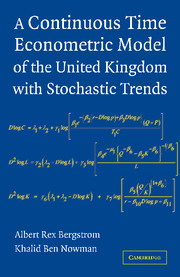Book contents
- Frontmatter
- Contents
- List of Figures and Tables
- Foreword by Peter C. B. Phillips
- Preface
- 1 Introduction to Continuous Time Modelling
- 2 Continuous Time Econometrics with Stochastic Trends
- 3 Model Specification
- 4 Steady State and Stability Analysis
- 5 Empirical Estimation of the Model and Derived Results
- References
- Author Index
- Subject Index
2 - Continuous Time Econometrics with Stochastic Trends
Published online by Cambridge University Press: 03 March 2010
- Frontmatter
- Contents
- List of Figures and Tables
- Foreword by Peter C. B. Phillips
- Preface
- 1 Introduction to Continuous Time Modelling
- 2 Continuous Time Econometrics with Stochastic Trends
- 3 Model Specification
- 4 Steady State and Stability Analysis
- 5 Empirical Estimation of the Model and Derived Results
- References
- Author Index
- Subject Index
Summary
Introduction
This chapter is concerned with the general econometric methodology used throughout the book. The main objective is to exposit the newly developed exact Gaussian estimation method for continuous time econometric models that incorporate unobservable stochastic trends. The approach is based on the article of Bergstrom [1997], and readers are referred to this article for proofs of the various results used. Bergstrom [1997] extends the exact Gaussian estimation method developed in earlier work (Bergstrom [1983, 1985, 1986, 1990]) in two ways. Firstly, the algorithm is applicable to models incorporating unobservable stochastic trends. These can provide a more flexible and realistic representation of such unobservable trend variables as technical progress, which have often been represented in econometric models in the past by deterministic trends. Secondly, the algorithm is applicable to models formulated as systems of mixed-order stochastic differential equations, even when the discrete observations of the variables are a mixture of stocks and flows. Hitherto, the problem of estimating mixed-order continuous time systems has been dealt with only for the special case in which all the variables are measured at equispaced points of time, i.e. there are no flow variables (see Agbeyegbe [1984]). The new algorithm is applicable, therefore, to models that, in addition to incorporating unobservable stochastic trends, involve all the complications assumed in the earlier work on the exact Gaussian estimation of continuous time macroeconometric models.
- Type
- Chapter
- Information
- Publisher: Cambridge University PressPrint publication year: 2007



